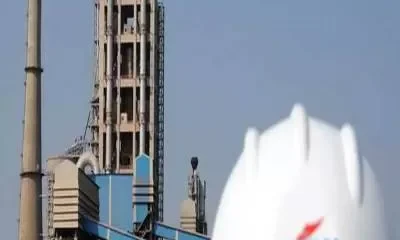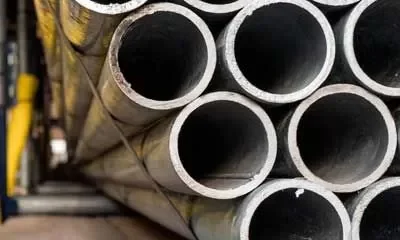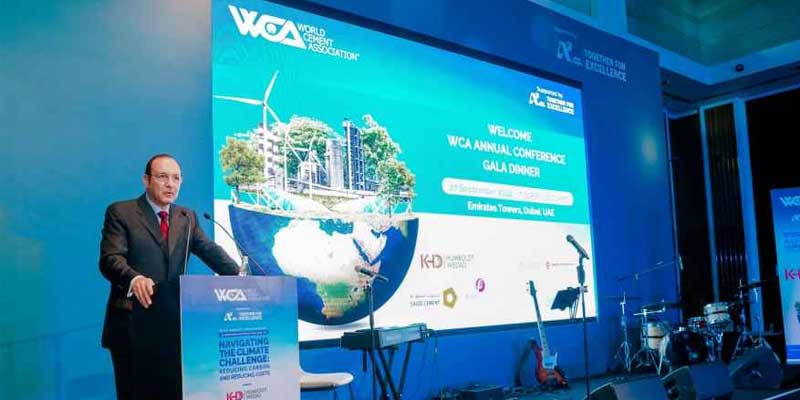Technology
Deccan Pride
-

 Concrete4 weeks ago
Concrete4 weeks agoGrinding aids help in reducing the agglomeration of particles
-

 Concrete2 weeks ago
Concrete2 weeks agoSEBI Places JSW Cement’s Rs.4,000 Cr IPO on Hold
-

 Concrete3 weeks ago
Concrete3 weeks agoJSW Cement Targets Doubling of Cement Grinding Capacity
-

 Uncategorized4 weeks ago
Uncategorized4 weeks agoTata Steel Explores Nuclear Power for Green Steel Production
Technology
Deccan Pride

Concrete
Smart Cement Plants

By integrating advanced technologies like IoT and AI, cement plants are transforming into highly efficient and interconnected systems. ICR explores how these innovations enable real-time monitoring and predictive maintenance, significantly reducing downtime and operational costs.
The cement industry, traditionally known for its reliance on heavy machinery and manual processes, is undergoing a significant digital transformation. This shift is driven by advancements in technology that promise to enhance efficiency, reduce costs, and improve overall production quality. Key trends include the adoption of the Internet of Things (IoT), which enables real-time monitoring and control of production processes through interconnected devices. Artificial Intelligence (AI) and Machine Learning (ML) are being utilised to optimise operations, predict maintenance needs, and minimise downtime by analysing vast amounts of data. Additionally, the integration of Big Data analytics allows for more informed decision-making by providing insights into production trends and potential areas for improvement.
“One of the key advantages of integrating data across our systems is the ability to have a more transparent, agile, and integrated supply and logistics chain. With the implementation of Oracle Logistics Management Solution, we have been able to overcome challenges related to consignment locations and truck movements, providing real-time visibility into our operations. This has also led to operational efficiency improvements and the ability to predict consignment delivery times, which we share with our customers, enhancing their experience” says Arun Shukla, President and Director, JK Lakshmi Cement.
According to BlueWeave Consultancy, during the forecast period between 2023 and 2029, the size of India cement market is projected to grow at a CAGR of 9.05 per cent reaching a value of US$ 49.24 billion by 2029. Major growth drivers for the India cement market include the growing need from construction and infrastructure sectors and rising governmental initiatives and investments in expansive infrastructure ventures encompassing highways, railways, airports, and public edifices.
Importance of Digitalisation
Digitalisation in cement manufacturing is crucial for several reasons:
- Enhanced efficiency: Digital tools streamline production processes, reducing waste and improving the precision of operations. This leads to higher output and better resource utilisation.
- Predictive maintenance: By leveraging AI and IoT, cement plants can predict equipment failures before they occur, minimising unplanned downtime and extending the lifespan of machinery.
- Energy optimisation: Digital technologies enable the monitoring and optimisation of energy consumption, leading to significant cost savings and a reduced carbon footprint.
This aligns with global sustainability goals and regulatory requirements.
Quality control: Advanced sensors and data analytics ensure consistent product quality by closely monitoring and adjusting the production parameters in real time.
Safety improvements: Automation and robotics reduce the need for human intervention in hazardous environments, enhancing worker safety and reducing the risk of accidents.
Competitive advantage: Companies that embrace digitalisation can respond more quickly to market changes, innovate faster, and provide better customer service, giving them a competitive edge in the industry.
Digital transformation is reshaping the cement industry by driving efficiency, enhancing product quality, and promoting sustainability. As the industry continues to evolve, the adoption of digital technologies will be essential for maintaining competitiveness and achieving long-term success.
Key technologies driving digitalisation
The digital transformation of the cement industry is powered by a suite of advanced technologies that enhance efficiency, improve product quality, and drive sustainability. Here are some of the key technologies making a significant impact:
IoT refers to a network of interconnected devices that communicate and exchange data in real time. In the cement industry, IoT applications are revolutionising operations by enabling real-time monitoring and control of production processes. Sensors embedded in equipment collect data on various parameters such as temperature, pressure, and vibration. This data is then transmitted to a central system where it is analysed to optimise performance. For instance, IoT-enabled predictive maintenance systems can detect anomalies and predict equipment failures before they occur, minimising downtime and reducing maintenance costs. Additionally, IoT helps in energy management by monitoring consumption patterns and identifying opportunities for energy savings.
AI and ML in process optimisation are pivotal in enhancing process optimisation in the cement industry. AI algorithms analyse vast amounts of data generated from production processes to identify patterns and insights that human operators might overlook. ML models continuously learn from this data, improving their accuracy and effectiveness over time. These technologies enable real-time adjustments to production parameters, ensuring optimal performance and product quality. For example, AI-driven systems can automatically adjust the
mix of raw materials to produce cement with consistent properties, reducing waste and improving efficiency. AI and ML also play a crucial role in predictive maintenance, forecasting potential issues based on historical data and preventing costly equipment failures.
Tushar Kulkarni, Head – Solutions, Innomotics India, says, “Adoption of artificial intelligence (AI) will significantly help cement plants in their efforts towards innovation, efficiency and sustainability goals through improved process optimisation and increased productivity.”
“The Innomotics Digi-Suite (AI-based) is positioned to support the cement industry in this endeavour. Built on microservices architecture, Digi-Suite offers flexible self-learning AI based solutions which can be customised or tailor-made in accordance with plant / customer requirements. It enables customers to implement their digitalisation strategies in a stepwise manner and scale it up to an entire plant or multiple plants. Through this platform, customers can monitor and manage processes centrally. This approach provides guidance for company-wide process standardisation, knowledge sharing and optimum utilisation of expert resources,” he adds.
Big Data analytics involves processing and analysing large volumes of data to extract meaningful insights. In the cement industry, Big Data analytics is used for predictive maintenance and strategic decision-making. By analysing data from various sources such as sensors, machinery logs, and production records, companies can predict equipment failures and schedule maintenance activities proactively. This approach minimises unplanned downtime and extends the lifespan of critical assets. Furthermore, Big Data analytics helps in optimising supply chain management, inventory control, and production planning by providing actionable insights into trends and patterns. Decision-makers can leverage these insights to make informed choices that enhance operational efficiency and competitiveness.
Arun Attri, Chief Information Officer, Wonder Cement, says, “The advantages of data integration are substantial. By leveraging integrated data,
we build a single source of truth, we can identify patterns, optimise processes, and implement strategic initiatives that drive overall business growth. This approach not only enhances operational efficiency but also strengthens our relationships with all stakeholders by providing a clear and consistent view of our operations.”
“By establishing a single source of truth, we ensure that all stakeholders, both internal and external, have access to consistent and accurate data. This unified data repository enhances visibility into our operations, improves decision-making, and enables comprehensive analyses. For internal stakeholders, such as our production, quality and maintenance teams, this means having reliable data to optimise processes and schedule maintenance effectively. For external stakeholders, including suppliers and customers, it ensures transparency and trust, as they can rely on the accuracy of the information provided,” he adds.
Cloud computing offers a scalable and flexible solution for data storage and access, playing a vital role in the digitalisation of the cement industry. By storing data in the cloud, companies can easily access and share information across different locations and departments. Cloud-based platforms facilitate real-time collaboration and data sharing, enabling seamless integration of various digital tools and systems. Additionally, cloud computing provides robust data security and backup solutions, ensuring that critical information is protected and can be recovered in case of data loss. The scalability of cloud services allows cement manufacturers to handle the increasing volume of data generated by IoT devices and other digital technologies, supporting their growth and innovation initiatives.
Digital twin technology
Digital twin technology involves creating a virtual replica of a physical asset, process, or system. This digital counterpart is continuously updated with real-time data from sensors and other sources, mirroring the physical entity’s performance, behaviour and condition. In the cement industry, digital twins
offer numerous benefits. They enable real-time monitoring and analysis, allowing operators to visualise and understand complex processes in detail. This enhanced visibility helps in optimising production, improving efficiency, and reducing downtime. Digital twins also facilitate predictive maintenance by simulating various scenarios and identifying potential issues before they occur, thereby extending the lifespan of equipment and minimising maintenance costs. Moreover, they support data-driven decision-making by providing comprehensive insights into operations, leading to better resource management and increased productivity.
Tarun Mishra, Founder and CEO, Covacsis, explains, “Different plant data reside within the walls of individual plants. Comparing micro economic performance across plants is impossible. Covacsis’ IPF is designed to aggregate multiple plant’s data at unified enterprise datalike (historian) which then further used for relative baselining and relative performance analysis across same and similar asset base or product or processes.”
“Data plays the most important role in any algorithm. Big data and fast data are only adding to the logistics performance of any algorithm and platform. Covacsis is a decade old and most mature platform in the world. Covacsis’ SaaS infrastructure is already handling more than 350 billion of cement process and operation data on a daily basis with a compounding daily growth rate of 1 per cent. This provides a significant advantage to Covacsis towards building algorithms and ensuring the value efficacy of these algorithms for the industry,” he elaborates.
The implementation of digital twins in cement plants involves several steps. First, detailed models of the plant’s equipment, processes, and systems are created using data from various sources such as sensors, historical records, and engineering specifications. These models are then integrated into a digital platform that continuously collects and analyses real-time data from the physical plant. For instance, a digital twin of a cement kiln can monitor temperature, pressure, and other critical parameters, allowing operators to optimise the combustion process and improve energy efficiency.
Similarly, digital twins of grinding mills can help in adjusting operational parameters to achieve optimal particle size distribution and improve cement quality. The integration of digital twins with other digital technologies such as IoT, AI and Big Data analytics enhances their capabilities, providing a comprehensive and dynamic view of the entire production process. As a result, cement plants can achieve significant improvements in operational efficiency, product quality and sustainability.
Automation in cement production
Automation plays a pivotal role in enhancing productivity within the cement industry by streamlining operations and reducing the reliance on manual labor. Automated systems and machinery can perform repetitive and complex tasks with higher precision and consistency than human workers. This leads to significant improvements in operational efficiency and throughput. For instance, automated material handling systems can manage the movement and storage of raw materials and finished products more effectively, minimising delays and reducing handling costs.
Automated process control systems enable real-time monitoring and adjustments of production parameters, ensuring optimal performance and reducing waste. Additionally, automation helps in maintaining consistent product quality by minimising human errors and variations in the manufacturing process. Overall, the integration of automation technologies results in faster production cycles, lower operational costs, and increased competitiveness in the market.
The introduction of automation in the cement industry has a profound impact on workforce skills and safety. As automation takes over routine and hazardous tasks, the demand for manual labour decreases, and the focus shifts to more technical and supervisory roles. Workers are required to develop new skills in operating and maintaining automated systems, as well as in data analysis and problem-solving. This shift necessitates continuous training and upskilling to ensure the workforce can effectively manage and leverage advanced technologies.
On the safety front, automation significantly enhances worker safety by reducing their exposure to dangerous environments and tasks. Automated systems can handle heavy lifting, high-temperature processes, and exposure to harmful dust and chemicals, thereby minimising the risk of accidents and occupational health issues. As a result, automation not only boosts productivity but also contributes to a safer and more skilled workforce, fostering a more sustainable and resilient industry.
Energy efficiency and sustainability
Digital tools are revolutionising the way energy consumption is monitored and optimised in the cement industry. Advanced sensors and IoT devices continuously collect data on energy usage across different stages of the manufacturing process. This real-time data is analysed using AI and machine learning algorithms to identify patterns, inefficiencies, and opportunities for energy savings. Energy management systems (EMS) integrate these digital tools to provide a comprehensive overview of energy consumption, allowing operators to make informed decisions to reduce energy waste. For instance, predictive analytics can forecast energy demands and optimise the operation of high-energy equipment, such as kilns and grinders, to align with periods of lower energy costs. Additionally, automated control systems can adjust operational parameters to maintain optimal energy efficiency, thereby reducing the overall energy footprint of the plant.
McKinsey & Company for the cement industry analyse that pursuing digitisation and sustainability levers are key to significantly boosting productivity and efficiency of a typical cement plant. The result is a margin gain of $4 to $9 per tonne of cement, which would shift a traditional plant to the top quartile of the cost curve for plants with similar technologies.
Digital technologies are also instrumental in driving sustainable practices within the cement industry. By providing precise control over production processes, digital tools help in minimising raw material wastage and reducing emissions. For example, advanced process control (APC) systems optimise the combustion process in kilns, leading to more efficient fuel use and lower carbon dioxide emissions. Digital twins, which create virtual replicas of physical assets, enable detailed simulations and scenario analyses, allowing companies to explore and implement more sustainable production methods. Furthermore, the integration of renewable energy sources,
such as solar and wind power, is facilitated by digital technologies that manage and balance energy loads effectively.
Digital platforms also support the implementation of circular economy practices, such as the use of alternative fuels and raw materials, by tracking and optimising their utilisation throughout the production cycle. Overall, digital technologies empower the cement industry to achieve significant advancements in energy efficiency and sustainability, contributing to environmental conservation and compliance with global sustainability standards.
Future of digitalisation
The cement industry is on the brink of a significant transformation driven by emerging technologies. Innovations such as artificial intelligence (AI), machine learning (ML), advanced robotics, and blockchain are poised to revolutionise various aspects of cement production and supply chain management. AI and ML will enable more sophisticated predictive maintenance and process optimisation, reducing downtime and increasing efficiency. Advanced robotics will automate more complex and hazardous tasks, further enhancing productivity and worker safety. Blockchain technology offers potential benefits in enhancing transparency and traceability in the supply chain, ensuring the integrity of product quality and compliance with environmental regulations. These emerging technologies will collectively contribute to a more efficient, reliable, and sustainable cement industry.
Smart cement plants represent the future of the industry, where digital technologies are fully integrated to create highly automated and interconnected production environments. In these plants, IoT devices, digital twins and AI-driven systems will work together seamlessly to monitor, control and optimise every aspect of the manufacturing process. Real-time data from sensors will feed into advanced analytics platforms, enabling instant adjustments to maintain optimal performance. Digital twins will allow operators to simulate and test changes in a virtual environment before implementing them in the physical plant, minimising risks and enhancing decision-making. Furthermore, smart cement plants will incorporate renewable energy sources and energy storage solutions, supported by intelligent energy management systems that ensure efficient and sustainable operations.
Over the next decade, the digital transformation of the cement industry is expected to accelerate, driven by continuous advancements in technology and increasing demands for sustainability. We can anticipate widespread adoption of AI and ML for real-time process optimisation and predictive maintenance, leading to significant reductions in operational costs and emissions. The use of digital twins will become standard practice, enabling more precise and flexible production planning and execution.
Enhanced connectivity and data sharing across the supply chain will improve efficiency, transparency, and collaboration among stakeholders. Additionally, the integration of renewable energy and advanced energy storage solutions will become more prevalent, supported by digital platforms that optimise energy usage and reduce environmental impact. As the industry embraces these digital innovations, we will see a new era of smart, sustainable, and highly efficient cement manufacturing, positioning it to meet the challenges and opportunities of the future.
Conclusion
The digital transformation of the cement industry is poised to revolutionise traditional manufacturing processes, driving significant advancements in efficiency, sustainability, and competitiveness. Emerging technologies such as IoT, AI, ML advanced robotics, and blockchain are not only optimising energy consumption and improving operational efficiency but are also paving the way for more sustainable practices. The evolution towards smart cement plants, where digital tools are fully integrated, is set to redefine production environments with enhanced automation, real-time monitoring and advanced analytics.
Over the next decade, we can expect these technologies to become standard practice, leading to substantial reductions in costs and emissions, improved supply chain transparency, and greater adoption of renewable energy sources. As the industry embraces digitalisation, it will be better equipped to meet future challenges and seize new opportunities, ultimately contributing to a more sustainable and resilient
global economy.
– Kanika Mathur
Concrete
Advantages of data integration are substantial

Arun Attri, Chief Information Officer, Wonder Cement, discusses the digital transformation and advanced technologies used to enhance operational efficiency, sustainability and cybersecurity in their cement manufacturing processes.
How has the implementation of IT initiatives transformed your operations and processes in the cement industry?
We operate under the digital vision: To leverage digital to accelerate growth, build relationships and enhance consumer experience.
Our digital transformation initiatives have profoundly reshaped operations and processes at Wonder Cement. By integrating advanced technologies such as IoT, cloud computing and constructing a data lake house for data consolidation as a single source of truth, we have enabled seamless information flow between applications and developed real-time analytics. These advancements have streamlined our production processes, enhanced operational efficiency, and improved decision-making. Additionally, predictive analytics allows us to anticipate market trends and customer needs more accurately.
Can you discuss how your organisation is adopting Industry 4.0 technologies and the benefits you are experiencing?
Embracing Industry 4.0 technologies is truly transforming our operations and improving reliability. Here are the key benefits we are experiencing:
- Real-time monitoring: IoT devices provide real-time data on equipment performance, enabling predictive maintenance and reducing downtime.
- Process optimisation: AI and machine learning algorithms enhance process optimisation,
leading to increased efficiency and reduced operational costs. - Higher productivity: Improved monitoring and optimisation result in higher productivity and better product quality.
- Enhanced sustainability: Better resource utilisation contributes to enhanced sustainability.
What specific automation technologies have you implemented, and how have they improved efficiency and productivity in your cement plants?
Automation technologies have revolutionised efficiency and productivity at our cement plants. Automated quality control systems ensure consistent product quality by continuously monitoring and adjusting production parameters. Robotic process automation (RPA) in administrative functions like inventory management and order processing has drastically reduced manual errors and boosted operational efficiency. These advancements enable us to uphold high standards of precision and reliability, optimise resource utilisation and minimise wastage.
How are predictive analytics and maintenance technologies being utilised in your operations to minimise downtime and optimise maintenance schedules?
Predictive analytics and maintenance technologies are pivotal in minimising downtime and optimising maintenance schedules at Wonder Cement. By analysing historical data and real-time sensor inputs, we proactively predict and address potential equipment failures. This approach has drastically reduced unplanned downtime, enhanced equipment reliability, and extended machinery lifespan. Our maintenance teams use these insights to schedule activities during planned shutdowns, ensuring minimal production disruption. This proactive strategy has led to substantial cost savings and significantly boosted overall plant efficiency.
What are the challenges and advantages of integrating data across various systems in your cement manufacturing process?
Integrating data across various systems in our cement manufacturing process presents both challenges and advantages. One of the primary challenges is ensuring data consistency and accuracy across different platforms. To address this, we have implemented robust data integration and validation frameworks that facilitate seamless data flow and synchronisation.
The advantages of data integration are substantial. By leveraging integrated data, we build a single source of truth, we can identify patterns, optimise processes, and implement strategic initiatives that drive overall business growth. This approach not only enhances operational efficiency but also strengthens our relationships with all stakeholders by providing a clear and consistent view of our operations.
By establishing a single source of truth, we ensure that all stakeholders, both internal and external, have access to consistent and accurate data. This unified data repository enhances visibility into our operations, improves decision-making, and enables comprehensive analyses. For internal stakeholders, such as our production, quality and maintenance teams, this means having reliable data to optimise processes and schedule maintenance effectively. For external stakeholders, including suppliers and customers, it ensures transparency and trust, as they can rely on the accuracy of the information provided.
How is digitalisation contributing to sustainability efforts and reducing the environmental impact of your cement production?
IT initiatives play a pivotal role in supporting our sustainability efforts and reducing the environmental impact of cement production at Wonder Cement. One of the key contributions of IT is the optimisation of energy consumption. Through advanced energy management systems, we continuously monitor and analyse energy usage across our operations. This allows us to identify areas of inefficiency and implement measures to reduce energy consumption, such as adjusting process parameters and utilising energy-efficient equipment.
Additionally, IT enables us to track and manage emissions more effectively. By integrating emission monitoring systems with our IT infrastructure, we can continuously measure and analyse emission levels, ensuring compliance with environmental regulations and identifying opportunities for reduction. For instance, real-time data on CO2 emissions allows us to adjust our production processes to minimise the carbon footprint.
IT initiatives also facilitate the implementation of circular economy practices. Through sophisticated waste management systems, we can monitor and optimise the use of alternative fuels and raw materials, reducing our reliance on traditional resources and minimising waste generation.
With the increasing digitisation of operations, what steps are you taking to ensure cybersecurity and protect sensitive data?
With the increasing digitisation of operations, ensuring cybersecurity and protecting sensitive data is paramount at Wonder Cement. We have implemented advanced technologies such as artificial intelligence and machine learning (AI/ML) for threat detection and response, and Secure Access Service Edge (SASE) to provide secure and efficient network access. Additionally, our Security Operations Centre (SOC) continuously monitors our digital infrastructure, utilising AI/ML to identify and mitigate potential threats in real-time. Comprehensive cybersecurity measures, including firewalls, intrusion detection systems, and regular security audits, further safeguard our systems. We also conduct regular training sessions for our employees to raise awareness about cybersecurity best practices and potential threats. By prioritising cybersecurity, we ensure the confidentiality, integrity, and availability of our critical data and systems, staying ahead of emerging cyber threats.
What future IT trends do you foresee having the most significant impact on the cement industry, and how is your organisation preparing to embrace these trends?
Looking ahead, we foresee several IT trends that will significantly impact the cement industry. These include the further integration of AI and machine learning for advanced process optimisation, the adoption of blockchain technology for transparent and secure supply chain management, and the expansion of IoT applications for enhanced monitoring and control. Additionally, the use of drones for site inspections, computer vision for quality control, generative AI for innovative design solutions, and robotics and RPA for automating repetitive tasks will bring substantial benefits. At Wonder Cement, we are actively preparing to embrace these trends by investing in research and development, collaborating with technology partners, and continuously upgrading our IT infrastructure. Our proactive approach ensures that we remain at the forefront of technological advancements, driving innovation and maintaining our competitive edge.
– Kanika Mathur
Concrete
WCA’s annual conference

At the World Cement Association’s annual conference the WCA Director, Emir Adiguzel addressed the global cement industry to outline the challenges and opportunities facing the global cement industry.
The conference held in Nanjing, had industry leaders, innovators and stakeholders in attendance to discuss the future of cement production and sustainability. The WCAA director emphasised on the cement industry’s stern commitment to sustainability; spoke about the global cement demand and market dynamics, projecting a period of stagnation from 2024-2030 with growth expected only in the Middle east, India and Africa; about the challenges and opportunities in carbon capture technology hat show promise but will need further development and substantial investment as well as about the strategic initiatives and collaboration within the industry in improving sustainability and operational performance.
Adiguzel concluded his address by highlighting the crucial point where the global cement industry stands by saying “Collaboration within the World Cement Association is essential for sharing knowledge and aligning on long-term objectives. Ensuring the industry’s resilience and adaptation to evolving market dynamics is crucial for the survival of independent cement producers”.
-

 Concrete4 weeks ago
Concrete4 weeks agoGrinding aids help in reducing the agglomeration of particles
-

 Concrete2 weeks ago
Concrete2 weeks agoSEBI Places JSW Cement’s Rs.4,000 Cr IPO on Hold
-

 Concrete3 weeks ago
Concrete3 weeks agoJSW Cement Targets Doubling of Cement Grinding Capacity
-

 Uncategorized4 weeks ago
Uncategorized4 weeks agoTata Steel Explores Nuclear Power for Green Steel Production








Leave a Reply